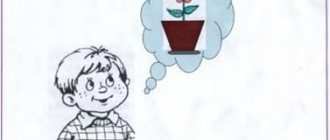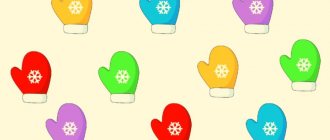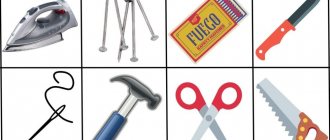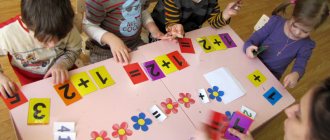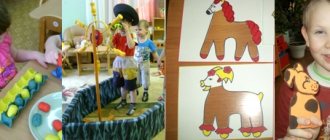Junior group
For younger preschoolers, simple educational, active and musical games are recommended.
Post a flower
Make two paper daisies for the game with the petals separated from the core. The number of petals must correspond to the number of players. Place daisies on the floor near the wall. Divide the students into 2 groups with an equal number of players.
Invite teams to move their daisy to the opposite wall. Each player transfers only one part of the plant: the first - the yellow core, the second - the petal, and so on. A player is not allowed to take two petals at once. The next participant starts moving when the previous one returns to the start. The team that collects its daisy first wins.
Collect a bouquet
Before playing, tell the children what parts flowers are made of: core, petals, stems and leaves. Cut out plant parts from colored paper and glue them into a bouquet arrangement, but do not glue the petals. Make petals of a certain color from the main spectrum for each flower. Tell the students that the wind tore off the petals, which now need to be selected according to the color for each plant in the bouquet.
You can also offer students a similar didactic game “Collect a flower.”
Bells
Children choose a leader by lot. He leaves the room. The players hide a picture depicting a blooming bell in the game room, disassemble the musical instruments themselves - small bells, and distribute them throughout the room. Moreover, one of the players must stand close to the hidden image.
The presenter enters the playroom, begins to walk around it, and approaches the children. When he approaches a player who is standing far from the picture, he does not ring the bell. When he approaches a participant standing closer to the picture, he makes a quiet ringing sound. The leader approaches the target even closer - the player makes a louder sound. The participant closest to the others rings the loudest. This way the presenter understands where to go in searching for the picture.
A flower is blooming
The game is educational. First tell the children how flowers bloom in nature. Prepare plant templates and distribute to students. Show how to curl the petals. Let the children put the flowers in a glass of water and observe what happens to the petals. When exposed to moisture, the petals will begin to “bloom.”
Middle group
Older preschoolers should know where flowers grow, what features and properties different types of plants have. It is important to instill in students a love for the nature of their native land. We must not forget about the physical activity of the children.
Where does the flower grow
For the game, prepare pictures of flower beds, fields, forests. Make cards depicting flowers familiar to the children. Invite the players to distribute the cards according to the pictures of growing places.
Flower drawing competition
By participating in an art competition, children develop imagination, creative skills, and color perception.
For the competition, purchase or pick a large flower from your garden: tulip, peony, rose, sunflower, iris or other. Children prepare art supplies and sit at easels, if available, or tables. From the finished works they put together an exhibition and choose the winner of the competition whose work they liked the most.
Flowers
The didactic game “Flowers” develops speech skills, imaginative thinking, and the ability to select descriptive features.
Ask a question and let the children give descriptions. You cannot repeat yourself; for each correct answer the player receives a point. The participant with the most points wins.
Here are sample questions:
- What kind of rose? – beautiful, red, lush, fragrant, tender;
- What flowers have spines? – rose, rose hip, cactus, blackthorn, burdock;
- What flowers are perfume made from? – jasmine, lavender, rose, lily of the valley, peony;
- What plants are honey made from? – dandelion, linden, acacia, clover;
- What flowers are yellow? – sunflower, dandelion, narcissus, buttercup.
Flower catch-up
Each player chooses the name of the flower; they should not be repeated. The players decide by lot who is catching up. Let it be “Cornflower”. He names some other plant, for example, “Dandelion”. The player who chose the name “Dandelion” runs away. "Cornflower" catches up with him. When “Dandelion” feels like it is about to be overtaken, it may say out loud another flower, such as “Chamomile.” Then “Romashka” has to run away, “Cornflower” switches to her. If “Dandelion” does not have time to pronounce the word and is caught, then it becomes catching up.
Didactic games on the topic “Indoor plants” 3-4 years
Didactic games on the topic “ How do indoor plants affect our lives?”
"What changed?"
Didactic task.
Remember the location, find changes in their location.
Game actions.
Searches for changes in plant arrangement.
Rule.
watch what the teacher cleans up
.
Equipment
4-5 plants.
Progress of the game
. Houseplants are placed on the table in one row. The teacher asks you to look at and remember the location of the plants and close your eyes. At this time, the teacher changes places. “Now open your eyes and tell me what has changed, which plants have been rearranged? Show me where they stood before?
"Find the same one"
Didactic task.
Find objects by similarity.
Game action
. Children find changes in the arrangement of objects.
Rule.
It is impossible to watch how the teacher changes places of plants.
Equipment.
3-4 identical plants are placed on two tables in a certain sequence, for example ficus, flowering geranium, asparagus, fragrant geranium.
Progress of the game
. The teacher asks the children to take a good look at how the plants stand and close their eyes. At this time, he swaps the plants on one table. And then he asks the children to rearrange the pots the way they were before, comparing their arrangement with the order of the plants on another table.
After some repetitions, you can play the game with one set of plants (without visual control).
“Find the plant by description” -1
Didactic task.
Find a plant by description.
Game actions
. Search for a plant by description of its distinctive features.
Rule
. You can name a plant only after describing it.
Equipment
. 5-6 plants, of which several names are of the same family, but of different species (fragrant and zonal pelargonium)
Progress of the game.
The teacher arranges the plants so that the children can clearly see the features of the same name (say, Tradescantia), and then names the distinctive features of each plant. Children listen carefully to the story, then show the hidden plant.
“Find the plant by description” -2
Didactic task.
Find a plant by description.
Game actions
. Search for a plant by description of its distinctive features.
Rule
. You can name a plant only after describing it.
Equipment
. 5-6 plants, of which several names are of the same family, but of different species (fragrant and zonal pelargonium)
Progress of the game.
The teacher chooses and describes a houseplant for one of the children. The teacher reminds the sequence of description: first you need to say if there is a trunk and branches. Then remember what they are like (stand up straight, curl, hang down, thin, thick), describe the leaves, their shape, surface (smooth, rough, shaggy), color (dark green, light variegated, with stripes, etc.)
"Flower shop"
Contents of classes.
Together with the children, remember the names of plants, their parts, and the distinctive features of some of them.
Didactic task
. Describe, find and name objects based on their characteristic features.
Rule.
Name the department and describe the plant, without saying what it is called.
Progress of the game.
Houseplants are placed on the table so that children can clearly see each one. This is the Flower Shop. Buyers do not name the plant, but only describe it. The seller must recognize and name it, and then issue the purchase.
“Where is the nesting doll hiding?”
Didactic task.
Find an item using the listed characteristics.
Game action.
Finding a hidden toy.
Rule.
You cannot look where the teacher hides the nesting doll.
Equipment.
4 – 5 plants are placed on the table.
Progress of the game.
The children are shown a small matryoshka doll that “wanted to play hide and seek with them.” The teacher asks the children to close their eyes and at this time hides the toy behind one of the plants. Then the children open their eyes. “How to find a nesting doll? - asks the teacher. “Now I’ll tell you where she hid.” And the teacher says what the plant behind which the nesting doll “hid” looks like (like a tree, grass), describes its stem, leaves (shape, size, surface), flowers, their number, color. Children listen and then point to a plant and name it.
« Describe it, I’ll guess.”
Didactic task.
Find a plant according to the adult’s description.
Game action.
Guessing plants by riddle - description.
Rule.
First you need to find the plant that they will tell you about, and then name it.
Progress of the game
. The teacher describes one of the plants in the group room. Children must find it by description, and if it is familiar to them, then name it. Those plants whose names the children do not yet know are named by the teacher himself.
When describing, generally accepted terms should be used: “leaf shape”, “flower color”, etc. This will help children identify the distinctive and common characteristics of the plant.
"Where the Flowers Grow"
Contents of classes
. Children must learn that flowers in flower beds and indoor plants are grown for beauty. Flowers are given to people on holidays when they go to visit. Flowers bring joy. You can buy them at a flower shop. Tell that there are wildflowers, forest flowers, garden flowers, and indoor flowers. They have different stems, leaves, flowers.
Didactic task.
Group plants by place of growth, describe, compare their appearance.
Equipment.
Fresh flowers of different growths or pictures with their images.
Progress of the game
. Children look at the entire plant offering and determine which species they are. Compare by appearance, describe, group.
"Find the same one"
Didactic task
. Find objects by similarity.
Game actions.
Search for a similar item.
Rule.
You can show a recognized plant only upon a signal from the teacher, after listening to its description.
Equipment.
Identical plants placed on two tables or photographs depicting plants.
Progress of the game.
The teacher shows a plant in one of the words (photos), describes its characteristic features, and then invites the child to find the same plant in the group.
“Where is the plant hidden?”
Didactic task
. Remember the location of objects, find changes in their location.
Game actions.
Searches for changes in plant arrangement.
Rule
. You cannot watch what the teacher cleans up.
Equipment.
For the first game you need 4 - 5 plants, for subsequent ones - up to 7 - 8.
Progress of the game
. Houseplants are placed on the table in one row. The teacher asks all children sitting in a semicircle to take a good look and remember the plants and their location, and then close their eyes. At this time, the teacher changes places of the plants (first two plants, and then two - three). “Now open your eyes and tell me what has changed,” he suggests. – Which plants have been rearranged? Show me where they stood before." (Children show.)
Senior group
Games for older preschoolers should be aimed at developing logical thinking, speech, intelligence, curiosity, and perseverance. At this age, children must classify plants according to different characteristics, and preparation for school begins.
Turning into a flower
The game strengthens the facial muscles and promotes overall physical development.
Invite the students to use facial expressions and body movements to depict a flower, how it opens its petals, reaches out to the sunlight, bends its stem under the raindrops, and closes for the night.
Name the odd one out
For the game, prepare groups of cards: meadow species, forest, field, garden, water. There are 4 plants in each group, one of them does not correspond to the category. Lay out the cards in front of the players, ask them to name the extra type and explain their opinion.
For example: rose, tulip, clover, peony. Clover is not a garden plant, but a meadow plant.
Flowers
In addition to getting to know plants, the goal of the didactic game “Flowers” is physical training, developing dexterity and a sense of rhythm.
The children take turns playing. The player takes the ball, hits it on the floor or wall, catches it, and names a plant with each hit. He must name 5 species. You can't repeat yourself. If a player cannot remember the plant, then he gives the ball and the right to play to the next player.
Name the adjective
The game develops the skill of forming adjectives from nouns. Name the flower and the object. The player must name an adjective that is a qualitative attribute of this object:
- poppy, and the grain... poppy;
- chamomile, and the field... chamomile;
- a rose, and the bud... pink;
- acacia, and honey... acacia;
- cornflower, and the eyes... cornflower blue;
- dandelion, and the jam... dandelion.
Didactic games aimed at developing color perception
DIDACTIC GAMES AIMED AT DEVELOPMENT
COLOR PERCEPTION
Gifts for Fairies
Option
I Purpose.
Reinforce ideas about colors. Teach children to highlight colors, distracting from other characteristics of objects (shape, size, functionality)
Material.
Fairy dolls of different colors and shades. Toys and objects of different colors.
Children are invited to give a gift to the Flower Fairy. only the same color as the fairy herself.
At the initial stages, one fairy doll of a certain color is used.
Option
II Purpose.
Reinforce ideas about colors. Teach children to highlight colors, distracting from other characteristics of objects (shape, size, functionality)
Material.
Fairy dolls of different colors and shades cards - “rugs”, two or three geometric figures of each color of different shapes and sizes (different materials are used).
Children are invited to give gifts to the Colored Fairies. Hand out colored “tickets”, name the color, shape, size.
Find a flower of the same color
Target.
Teach children consistent visual examination and description of an object, its shape, indicating proportions, color, shade.
Material.
Typesetting canvas. Flowers of different colors, shades and sizes.
Place a butterfly on a flower of the desired color
Target
. Teach children consistent visual examination and description of an object, its shape, indicating proportions, color, shade.
Material
. Typesetting canvas. Flowers of different colors, shades and sizes. Butterflies.
The teacher names the flower or describes its distinctive features. He offers to find it and plant a butterfly on this flower.
Collect a seven-flowered flower
Target.
To consolidate children's knowledge about the relationship between the colors of the spectrum.
Material.
Green typesetting canvas. Heart petals 7 colors, 4 pieces of each color.
Find two identical hearts
Target.
To consolidate children's knowledge about the relationship between the colors of the spectrum. Learn to correlate objects by size and color.
Material.
Green typesetting canvas. Heart petals of different colors and flower sizes, 2 pcs of each color.
Sunbug
Target.
Introduce children to colors and shades and their names. Learn to compare objects by color by placing them next to each other.
Material.
Flowers with 6 petals of different shades - blue, green, red, 1 flower with multi-colored petals. The sun bugs are the same shade as each of the petals.
Choose an item by color
Target.
Exercise children in matching and grouping objects by color.
Material.
I
option.
Puzzle cards with colored objects and center squares in 6 primary colors.
II
.
Puzzle cards with colored objects and middle puzzles of primary colors and shades.
Children choose the middle of the puzzle of any color they like and select cards of the corresponding color.
Warm and cool colors
Purpose.
Reinforce the idea of grouping the colors of the spectrum into warm and cold.
Material.
Picture of the sun and snowflakes, circles of different colors of the spectrum and their shades.
Children are asked to identify the colors that suit the sun and those that suit the snowflake, and explain their choice.
Choose a palette
Target.
Teach children to find the color palette in which the picture was created.
Material.
Picture cards made in different colors and genres. Palette cards.
Children choose a large card with an image and from the palette cards select the one that matches the image. (For convenience, the same numbers are glued on the back side - the number on the card and the number on the palette correspond to each other).
The game can be played as a competition: who can choose the most correct palettes for the pictures.
Make a Dymkovo pattern
Target.
Teach children to make a pattern based on Dymkovo painting.
Material.
Elements of Dymkovo painting carved from dish sponge.
I'll be the hairdresser
Target.
To develop children's ability to trace patterns and complete drawing and cutting out the “hairstyle”.
Material.
Portrait templates, colored paper of different shades and formats, simple pencils, scissors.
Children model their hair using a portrait template.
Collect a flower
Target.
Practice the ability to select halves of one flower in accordance with color and shade.
Material.
Half cards featuring flowers, varying in color and style.
From the proposed set of cards, children make a flower. When all the flowers have been collected, children are asked to combine the cards into groups according to the style of the flower image.
Choose a vase for a flower
Target.
To develop color perception in children - the ability to distinguish up to five shades of the same color, and to correlate these shades with each other.
Material.
Cards, five shades of the same color, with flowers and pots.
Make a picture from geometric shapes
Target.
Teach children to make silhouette figures using geometric shapes. Develop imagination. Fix the names of the primary colors.
Material.
Sample cards, a set of geometric shapes of different colors and sizes.
Columbus egg
Target.
Teach children to make silhouette figures using all the parts, attaching one to the other, without overlapping one on top of the other. Develop sensory abilities, spatial representations, and integrity of perception.
Material.
An oval measuring 15x12cm, cut into 9 parts: 3 triangles (2 large, 1 small), 2 figures similar to a quadrangle, one of which is round, 4 figures (large and small), similar to a triangle, but with one side rounded. To make the game, we used cardboard, identically colored on one side and multi-colored on the other. Sample cards.
At the initial stage, children find similarities between the shapes of game elements and real objects.
Next, children are asked to create a silhouette figure according to the proposed model.
When children have mastered the techniques: they independently invent and make figures.
Tangram
Target.
To train children in the ability to compose new images from existing geometric shapes, based on a model and according to plan.
Material.
A square of cardboard, painted on one side with one color and multi-colored on the other, cut into 7 parts: 2 large, 1 medium, 2 small triangles, a square and a parallelogram.
Preparatory group
At this age, kindergarteners are preparing for school. They must have narration skills, tell from memory and visual material. It is important, with the help of games, to develop imagination, memory, spatial and color perception in future schoolchildren, to cultivate communication skills, a sense of beauty, the ability to build a dialogue, attentiveness, and perseverance.
What kind of flower are you?
Invite the students to “turn” into flowers. Each player chooses what kind of plant to become, but does not tell his comrades about it. Children take turns coming forward, depicting their flower using facial expressions and body movements, without uttering a word. The rest of the guys must guess what plant we are talking about.
Flower shop
For the game, prepare natural or artificial flowers. Children act as florists. The game is collective and teaches communication, teamwork, and organization.
The students make up a beautiful bouquet. Then they try to sell it to the teacher. At the same time, they must praise the bouquet, explain what plants were used, why they chose them, and for what purpose the flower arrangement is intended.
Flower names
The players form a circle. The teacher stands in the center, throws the ball to each child in turn, saying a name or an object named similar to a flower. The player who catches the ball must name the corresponding plant. For example: Vasily - cornflower, nail - carnation, Roman - chamomile, jug - water lily, Lilya - lily, Violetta - viola, toffee - iris. The player who finds it difficult to answer is eliminated from the circle.
